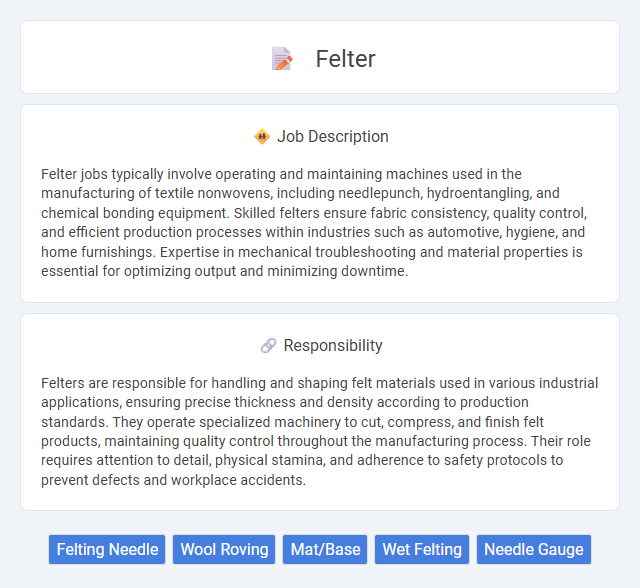
Felter jobs typically involve operating and maintaining machines used in the manufacturing of textile nonwovens, including needlepunch, hydroentangling, and chemical bonding equipment. Skilled felters ensure fabric consistency, quality control, and efficient production processes within industries such as automotive, hygiene, and home furnishings. Expertise in mechanical troubleshooting and material properties is essential for optimizing output and minimizing downtime.
Felters most likely thrive in environments requiring patience and manual dexterity, as their work involves manipulating fibers to create felt materials. Individuals who enjoy tactile tasks and have good hand-eye coordination probably find this job suitable. Those who prefer fast-paced or highly social roles may find felting less compatible with their strengths and preferences.
Qualification
A Felter must possess expert knowledge in fabric production techniques, including weaving, cutting, and finishing processes. Proficiency in operating industrial machinery and understanding textile properties is essential for quality control and efficiency. Strong problem-solving skills and attention to detail ensure adherence to safety standards and product specifications in textile manufacturing.
Responsibility
Felters are responsible for handling and shaping felt materials used in various industrial applications, ensuring precise thickness and density according to production standards. They operate specialized machinery to cut, compress, and finish felt products, maintaining quality control throughout the manufacturing process. Their role requires attention to detail, physical stamina, and adherence to safety protocols to prevent defects and workplace accidents.
Benefit
Working as a felter likely offers significant benefits such as job stability due to consistent demand in textile and craft industries. The role may provide opportunities for skill development, enhancing creative and technical abilities in fabric production. Employees might also experience a supportive work environment that encourages craftsmanship and attention to detail.
Challenge
Felters likely face significant challenges involving the precise handling of materials to ensure the durability and quality of textile products. The role probably demands problem-solving skills to address issues related to fabric consistency and machinery malfunctions. Meeting production deadlines while maintaining high standards may also present ongoing difficulties.
Career Advancement
Felters play a crucial role in the manufacturing and textile industries by assembling, installing, and maintaining felted materials used in machinery and products. Career advancement for felters often involves progressing to supervisory roles, quality control specialists, or production managers with experience and specialized technical skills. Gaining certifications in industrial maintenance or textile technology can significantly enhance job prospects and salary potential in this field.
Key Terms
Felting Needle
Felter jobs require precision and expertise in using felting needles to interlock fibers and create dense, durable textile materials. High-quality felting needles feature barbs along their shafts designed to repeatedly penetrate wool fibers, facilitating efficient matting and sculpting of felt art or fabric. Mastery of felting needle techniques enhances both the texture and strength of finished wool products, making skilled felters essential in artisanal crafts and industrial applications.
Wool Roving
Felters specializing in wool roving transform raw wool fibers into cohesive, dense felt fabric through techniques involving heat, moisture, and pressure. Wool roving's aligned fibers provide an ideal base for creating durable, textured felt products used in fashion, crafts, and industrial applications. Mastery in manipulating wool roving ensures consistent felt quality, essential for artisans and manufacturers relying on superior material performance.
Mat/Base
Felters specialize in manufacturing and maintaining felt materials used in industrial machinery, especially within the paper production sector. Their expertise includes assembling and repairing mats and bases that provide critical support and cushioning during mechanical processes. Proficiency in operating textile machines and applying precise measurements ensures the durability and efficiency of felting components in various manufacturing environments.
Wet Felting
Wet felting involves transforming wool fibers into dense, durable fabric using moisture, heat, and agitation. This traditional textile process is essential in creating custom felt for fashion, upholstery, and artistic projects. Mastery in wet felting requires precise control of water temperature, fiber arrangement, and pressure to achieve desired texture and strength.
Needle Gauge
Felters specializing in needle gauges meticulously select and maintain the optimal gauge size to enhance felting quality and efficiency. Fine needle gauges, such as 36 or 38, are ideal for detailed, delicate work, while coarser gauges like 36-42 facilitate faster compaction in larger projects. Understanding needle gauge impact on fiber penetration and fabric density is essential for precision in needle felting operations.
 kuljobs.com
kuljobs.com